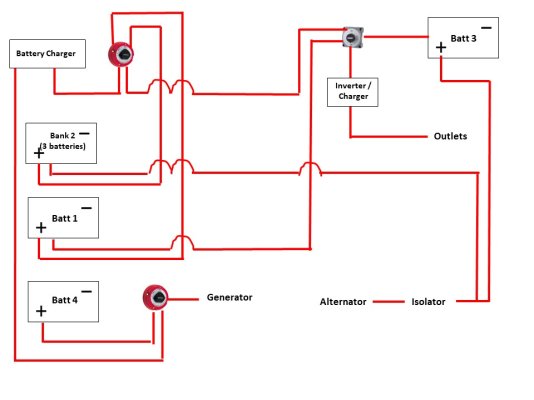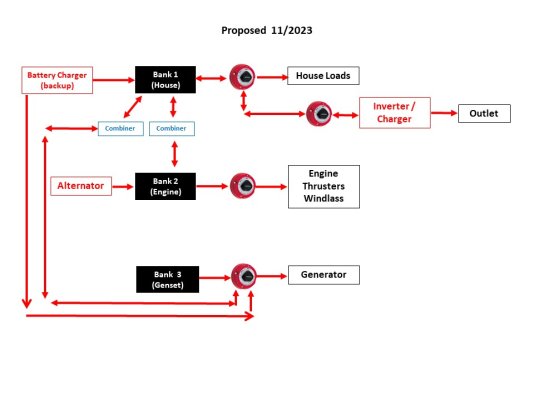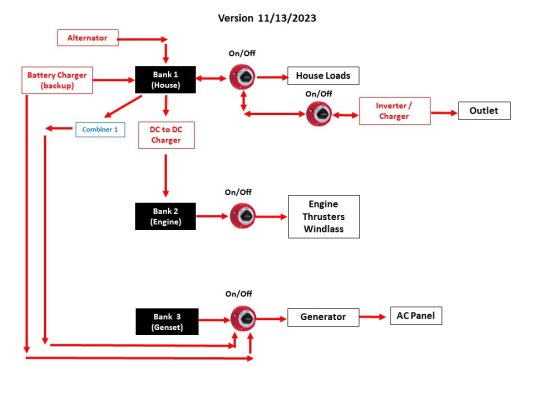LakeErieWX
Member
- Joined
- Aug 23, 2022
- Messages
- 20
Late last year we purchased a 2001 Mainship 34 Pilot. One of my projects for this winter is to make sense of the DC electrical system. I have a basic working knowledge of electrical systems, but this experience is based on owning older sailboats with much simpler systems (and no inverters). I am a bit confused by the arrangement I have inherited.
My current questions relate to charging and the connection between the batteries and the inverter charger. I have attached a simplistic diagram for reference.
There are 6 group 27 batteries on board and all are starting batteries. Three of the batteries are individual (#1, #3, and 4). Bank 2 contains three batteries in parallel.
Question 1: Battery 1 is connected to position 1 of the primary battery switch and the switch associated with the inverter. So even when the primary battery switch is off or set to position 2, battery 1 is connected to the inverter/charger. Is this standard?
Question 2: Battery 3 is connected directly to the inverter switch. It is charged via the alternator and the inverter/charger when the inverter is on A/C power. Based on my understanding of the wiring diagram, battery 3 would also be charged by the battery charger if the primary battery switch was in position 1 or All and the inverter switch was on. Is this correct?
Question 3: Based on the configuration, it seems that Bank 2 is the starting bank and battery 1 and 3 are for house loads. Does this seem correct?
Question 4: If battery 1 and 3 are for house loads, shouldn't they be deep cycle instead of starting batteries?
Question 5: Would it be simpler to combine battery 1 and 3 into a bank, connect the bank to position 1 of the primary battery switch, and remove the direct connection from battery 1 to the inverter switch?
Question 6: Would it be simpler to replace the 2 bank charger with a 3 bank unit and running the charging feature on the inverter?
Question 7: Would it be a better arrangement to replacing the battery isolator with an ACR?
Thanks!
Mark
My current questions relate to charging and the connection between the batteries and the inverter charger. I have attached a simplistic diagram for reference.
There are 6 group 27 batteries on board and all are starting batteries. Three of the batteries are individual (#1, #3, and 4). Bank 2 contains three batteries in parallel.
Question 1: Battery 1 is connected to position 1 of the primary battery switch and the switch associated with the inverter. So even when the primary battery switch is off or set to position 2, battery 1 is connected to the inverter/charger. Is this standard?
Question 2: Battery 3 is connected directly to the inverter switch. It is charged via the alternator and the inverter/charger when the inverter is on A/C power. Based on my understanding of the wiring diagram, battery 3 would also be charged by the battery charger if the primary battery switch was in position 1 or All and the inverter switch was on. Is this correct?
Question 3: Based on the configuration, it seems that Bank 2 is the starting bank and battery 1 and 3 are for house loads. Does this seem correct?
Question 4: If battery 1 and 3 are for house loads, shouldn't they be deep cycle instead of starting batteries?
Question 5: Would it be simpler to combine battery 1 and 3 into a bank, connect the bank to position 1 of the primary battery switch, and remove the direct connection from battery 1 to the inverter switch?
Question 6: Would it be simpler to replace the 2 bank charger with a 3 bank unit and running the charging feature on the inverter?
Question 7: Would it be a better arrangement to replacing the battery isolator with an ACR?
Thanks!
Mark




